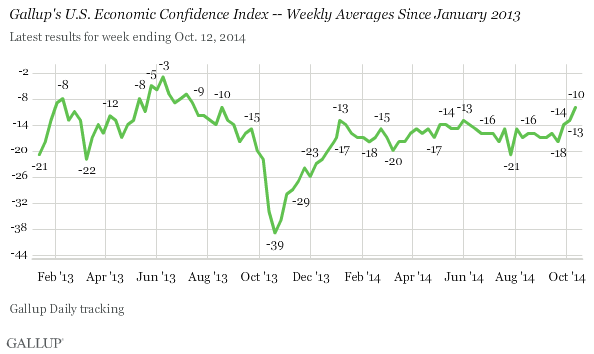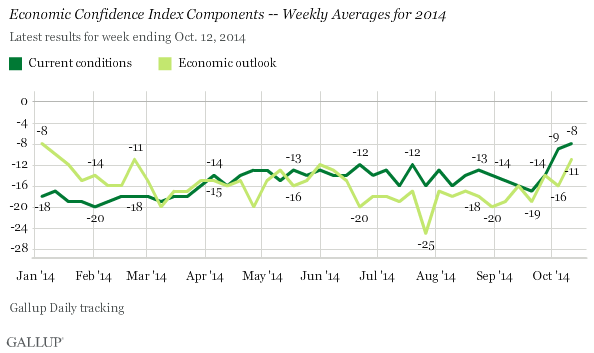WASHINGTON, D.C. -- Gallup's U.S. Economic Confidence Index rose to -10 for the week ending Oct. 12, up from -13 the week before. Last week's index reflects the highest score to date in 2014, and the highest weekly score since August 2013.

Last week marked the third consecutive week that the index increased. As a result, it has finally escaped the narrow -13 to -21 range it had stayed within all year prior to now. The recent run follows a short-lived dip in confidence to -18 in late September.
Although it is the best score this year, the current -10 is still below the -3 from early June 2013, the highest weekly score found since Gallup began tracking economic confidence daily in 2008. And it remains well below the hypothetical maximum of +100, reached if all Americans were to say the economy is excellent or good and getting better.
Gallup's Economic Confidence Index is the average of two components: Americans' views of current economic conditions and whether they think the economy will get better or will get worse. Both components saw increases last week, although the larger change was in Americans' economic outlook.
For the week ending Oct. 12, 22% of Americans said the economy was "excellent" or "good," while 30% said it was "poor." This results in a current conditions score of -8, up slightly from -9 the week prior, and the highest current conditions score found since the -6 in early February 2008, at the beginning of the Great Recession.
The economic outlook score also increased, to -11, from -16 the week before. This was the result of 42% of Americans saying the economy was getting better, compared with 53% who said it was getting worse. This is the highest weekly economic outlook score since late February.

Bottom Line
Despite a drop in stock market prices for the third week in a row, the U.S. Economic Confidence Index increased again last week, and has now reached a new high for 2014. This may reflect Americans' attention to other, more positive economic news -- particularly reports on the job market. The nation's unemployment rate is now approaching what it was before the recession, based on a September unemployment rate that was under 6%, according to the government. Gallup's Job Creation Index and Payroll to Population rate generally confirm a much better job market than has been the case in recent years.
Americans are more confident about the economy's direction now than they have been at any point since February, and their rating of current economic conditions has edged up to a high not seen since 2008.
Gallup.com reports results from these indexes in daily, weekly, and monthly averages and in Gallup.com stories. Complete trend data are always available to view and export in the following charts:
Daily: Employment, Economic Confidence and Job Creation, Consumer Spending
Weekly: Employment, Economic Confidence, Job Creation, Consumer Spending
Read more about Gallup's economic measures.
View our economic release schedule.
Survey Methods
Results for this Gallup poll are based on telephone interviews conducted Oct. 6-12, 2014, on the Gallup Daily tracking survey, with a random sample of 3,543 adults, aged 18 and older, living in all 50 U.S. states and the District of Columbia.
For results based on the total sample of national adults, the margin of sampling error is ±2 percentage points at the 95% confidence level.
Interviews are conducted with respondents on landline telephones and cellular phones, with interviews conducted in Spanish for respondents who are primarily Spanish-speaking. Each sample of national adults includes a minimum quota of 50% cellphone respondents and 50% landline respondents, with additional minimum quotas by time zone within region. Landline and cellular telephone numbers are selected using random-digit-dial methods. Landline respondents are chosen at random within each household on the basis of which member had the most recent birthday.
Samples are weighted to correct for unequal selection probability, nonresponse, and double coverage of landline and cell users in the two sampling frames. They are also weighted to match the national demographics of gender, age, race, Hispanic ethnicity, education, region, population density, and phone status (cellphone only/landline only/both, and cellphone mostly). Demographic weighting targets are based on the most recent Current Population Survey figures for the aged 18 and older U.S. population. Phone status targets are based on the most recent National Health Interview Survey. Population density targets are based on the most recent U.S. census. All reported margins of sampling error include the computed design effects for weighting.
In addition to sampling error, question wording and practical difficulties in conducting surveys can introduce error or bias into the findings of public opinion polls.
For more details on Gallup's polling methodology, visit www.gallup.com.
